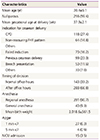1. American Academy of Pediatrics. American College of Obstetricians and Gynecologists. Guidelines for perinatal care. 5th ed. Elk Grove Village (IL): American Academy of Pediatrics;2002.
2. Royal College of Obstetrics and Gynaecology. Report of a joint working group: organization standards for maternity services. London (GB): Royal College of Obstetricians and Gynecologists Press;1995.
3. Schauberger CW, Chauhan SP. Emergency cesarean section and the 30-minute rule: definitions. Am J Perinatol. 2009; 26:221–226.

4. Bruce D, Stone S, Harding K. Evaluation of emergency caesarean sections--completion of the audit cycle in a Central London teaching hospital. J Obstet Gynaecol. 2002; 22:273–278.

5. Helmy WH, Jolaoso AS, Ifaturoti OO, Afify SA, Jones MH. The decision-to-delivery interval for emergency caesarean section: is 30 minutes a realistic target? BJOG. 2002; 109:505–508.

6. Livermore LJ, Cochrane RM. Decision to delivery interval: a retrospective study of 1,000 emergency caesarean sections. J Obstet Gynaecol. 2006; 26:307–310.

7. Royal College of Obstetrics and Gynaecology. Caesarean section: NICE clinical guideline 132. London (GB): Royal College of Obstetricians and Gynecologists Press;2011.
8. Leung TY, Lao TT. Timing of caesarean section according to urgency. Best Pract Res Clin Obstet Gynaecol. 2013; 27:251–267.

9. Bloom SL, Leveno KJ, Spong CY, Gilbert S, Hauth JC, Landon MB, et al. Decision-to-incision times and maternal and infant outcomes. Obstet Gynecol. 2006; 108:6–11.

10. Tuffnell DJ, Wilkinson K, Beresford N. Interval between decision and delivery by caesarean section-are current standards achievable? Observational case series. BMJ. 2001; 322:1330–1333.

11. Bello FA, Tsele TA, Oluwasola TO. Decision-to-delivery intervals and perinatal outcomes following emergency cesarean delivery in a Nigerian tertiary hospital. Int J Gynaecol Obstet. 2015; 130:279–283.

12. Chukwudi OE, Okonkwo CA. Decision - delivery interval and perinatal outcome of emergency caesarean sections at a tertiary institution. Pak J Med Sci. 2014; 30:946–950.

13. Onah HE, Ibeziako N, Umezulike AC, Effetie ER, Ogbuokiri CM. Decision - delivery interval and perinatal outcome in emergency caesarean sections. J Obstet Gynaecol. 2005; 25:342–346.
14. Boriboonhirunsarn D, Watananirun K, Sompagdee N. Decision-to-delivery interval in pregnant women with intrapartum non-reassuring fetal heart rate patterns. J Eval Clin Pract. 2016; 22:998–1002.

15. American Academy of Pediatrics. American College of Obstetricians and Gynecologists. Guidelines for perinatal care. 7th ed. Elk Grove Village (IL): American Academy of Pediatrics;2012.
16. Chauleur C, Collet F, Furtos C, Nourrissat A, Seffert P, Chauvin F. Identification of factors influencing the decision-to-delivery interval in emergency caesarean sections. Gynecol Obstet Invest. 2009; 68:248–254.

17. Sayegh I, Dupuis O, Clement HJ, Rudigoz RC. Evaluating the decision--to--delivery interval in emergency caesarean sections. Eur J Obstet Gynecol Reprod Biol. 2004; 116:28–33.

18. MacKenzie IZ, Cooke I. What is a reasonable time from decision-to-delivery by caesarean section? Evidence from 415 deliveries. BJOG. 2002; 109:498–504.

19. Fuhrmann L, Pedersen TH, Atke A, Møller AM, Østergaard D. Multidisciplinary team training reduces the decision-to-delivery interval for emergency caesarean section. Acta Anaesthesiol Scand. 2015; 59:1287–1295.

20. Weiner E, Bar J, Fainstein N, Ben-Haroush A, Sadan O, Golan A, et al. The effect of a program to shorten the decision-to-delivery interval for emergent cesarean section on maternal and neonatal outcome. Am J Obstet Gynecol. 2014; 210:224.e1–224.e6.

21. Hillemanns P, Strauss A, Hasbargen U, Schulze A, Genzel-Boroviczeny O, Weninger E, et al. Crash emergency cesarean section: decision-to-delivery interval under 30 min and its effect on Apgar and umbilical artery pH. Arch Gynecol Obstet. 2005; 273:161–165.
22. Holcroft CJ, Graham EM, Penning DH. Cord gas analysis, decision-to-delivery interval and the 30-minute rule for emergency cesareans. J Perinatol. 2005; 25:616.

23. Thomas J, Paranjothy S, James D. National cross sectional survey to determine whether the decision to delivery interval is critical in emergency caesarean section. BMJ. 2004; 328:665.











 PDF
PDF ePub
ePub Citation
Citation Print
Print



 XML Download
XML Download